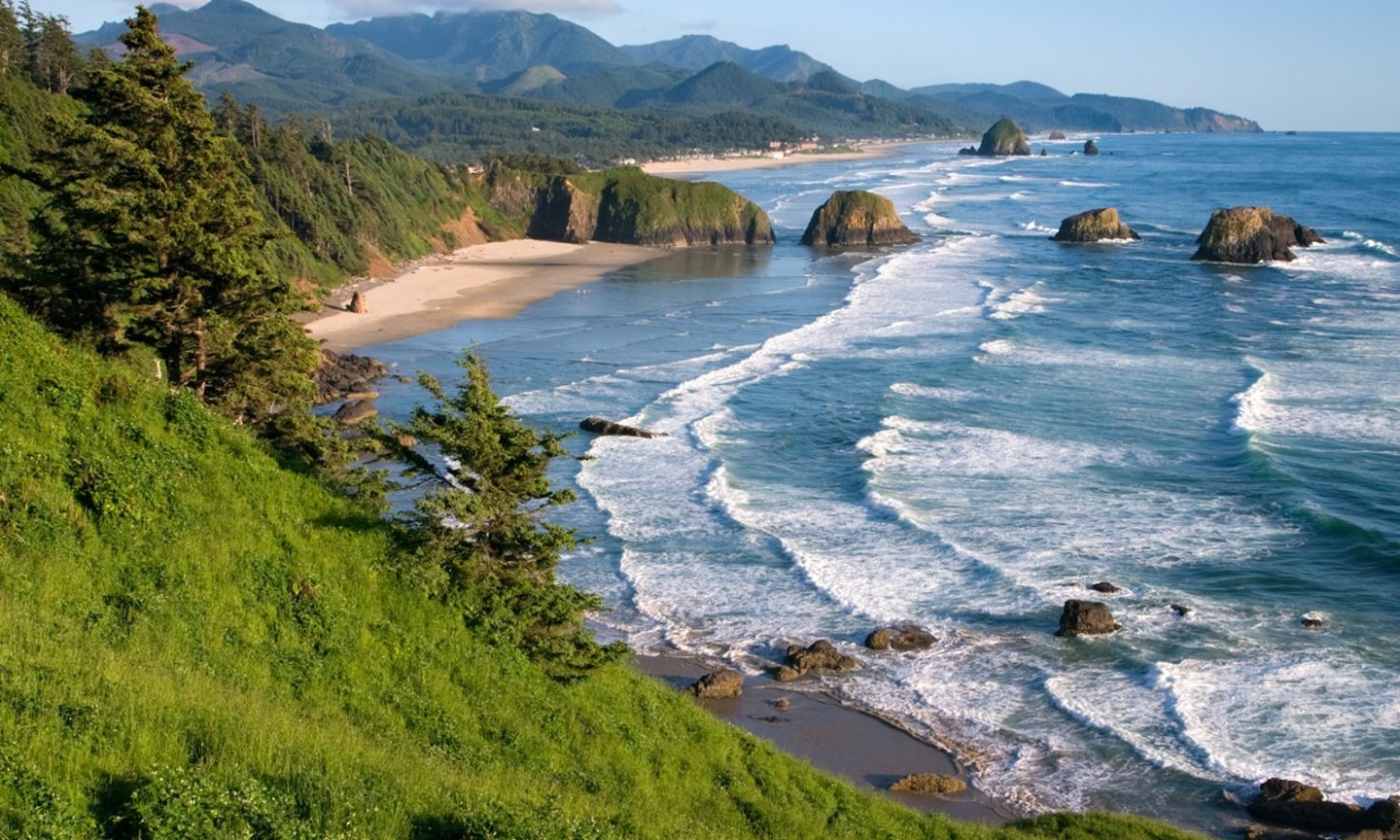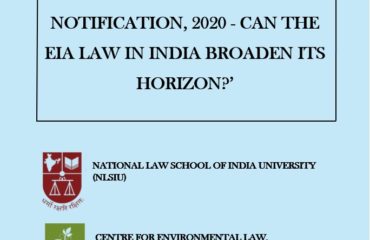COASTAL REGULATION ZONE: A JOURNEY FROM 1991 TILL 2019
– RAGHAV PARTHASARATHY & VIKAS GAHLOT
Teaching Associates, CEERA-NLSIU
Environment (Protection) Act, 1986, (‘EPA’ hereafter), was enacted pursuant to the decision that was taken at the United Nations Conference on Human Environment which was held at the Stockholm in June, 1972. An urgent need to enact a general legislation to address the issues of environmental safety was felt necessary[1]. Activities to ameliorate the economic conditions have always been on the rise, permeating through the fragile ecosystems, endangering the life and livelihood of the inhabitants. Coastal ecosystem being no exception to such a development, jeopardised the marine life. In order to cater to the needs of growing population, resources available in coastal area have to be utilised. Therefore, protection of these resources becomes crucial. Accordingly, the Government of India exercising the power vested under EPA and Environment (Protection) Rules, 1986, (‘Rules’ hereafter) has issued notification to regulate the activities in and around the coastal areas across India. Coastal zones had to be regulated to prevent the deterioration and to bring within the legal framework the protection of coasts and other water bodies under the Coastal Regulation Zone (CRZ).
- COASTAL REGULATION ZONE NOTIFICATION OF 1991
The first of the Notification was issued in the year 1991. The Coastal Regulation Zone Notification, 1991 (hereafter ‘Notification of 1991’) was notified exercising the powers conferred under Section 3(1) and 3(2)(v)[2] of EPA and Rule 5[3] of the Rules. The Central Government has placed certain restrictions on setting up and expansion of industries, operation of industries or processes, from operating in specific locations. Notification of 1991 is applicable to the coastal stretches of seas, bays, estuaries, creeks, rivers and backwaters, influenced by the tidal action up to 500 meters from High Tide Line (HTL) and land between Low Tide Line (LTL). It mandated the State Governments and the Union Territories to draw up the Coastal Zone Management Plan (CZMP)[4] to identify and classify the Coastal Regulation Zone within their respective territories. Powers were also vested under the Notification of 1991 to the State Governments, Union Territories and Local authorities to regulate developmental activities within the CRZ. The Notification of 1991[5] mandated obtaining the permission of Ministry of Environment and Forests[6], Government of India for specific types of projects which included the construction activities related to defence requirements[7], operational constructions for ports and harbours and light houses[8], thermal power plants[9] and any other activities with investment over and above rupees five crores[10]. Coastal areas under the notification were also classified into four zones viz., CRZ-I, CRZ-II, CRZ-III and CRZ-IV.
CRZ-I – Areas that are ecologically sensitive and important such as national parks, marine parks, sanctuaries and other important biologically sensitive areas and of heritage or of historical significance and also included the area between the LTL and HTL. It also laid down prohibition on any construction within the 500 meters of the High Tide Line and allowed[11] for constructions for carrying treated effluents and waste water discharges into sea, facilities for carrying sea water for cooling purposes, oil, gas and similar pipelines and facilities for essential activities.
CRZ-II – Developed Areas[12] which are developed up to or close to shore line are classified under the second category. CRZ-II however allowed for construction and reconstruction of buildings, subject to respective laws and mandated that the said buildings shall be consistent with surrounding landscape and local architectural style.
CRZ-III – Areas not falling within CRZ-I and CRZ-II are classified under CRZ-III, which are in the rural areas and also those areas which are not substantially built up. Introduced the ‘No Development Zone’ upto 200 meters from HTL. It permitted activities like agriculture, horticulture, gardening, pasturing, parks, playfields, forestry and salt manufacture. However, no new construction was allowed and only repairs of existing structures were allowed. Between 200 meters and 500 meters of HTL allowed for hotels and resorts for tourists as provided under Annexure – II to the Notification, construction and reconstruction of dwelling units with specified measurements, along with alteration of existing authorised building.
CRZ-IV – Covered the islands of Andaman and Nicobar, Lakshadweep and other small islands except those under CRZ-I, CRZ-II and CRZ-III. Restrictions on construction within the 200 meters of HTL imposed and prohibited the use of corals and sand from beaches and coastal waters, dredging and under water blasting in and around coral formations.
In one of the landmark decisions, the Supreme Court upheld the demolition of the residential building constructed in violation of the CRZ Notification of 1991. In the case of The Kerala State Coastal Zone Management Authority (KSCZMA) vs Maradu Municipality famously known as Maradu Apartments Demolition Case, is a landmark case in which a division bench of the Supreme Court comprising of Justice Arun Mishra and Justice Naveen Sinha has ordered the demolition of five apartments which were waterfront complexes in Maradu Municipality in Kerala for the violations of CRZ rules.
Maradu is an area which lies just 7 Km from Kochi. A gram panchayat for the area was formed in 1953 for its administration but was later converted into a municipality in 2010. In 2006 the panchayat issued building permits to four companies namely Alpha Ventures Private Limited, Holy Faith Builders and Developers, Jain Housing and Construction and K.V. Jose for the construction of five apartment Complexes. The permit was issued without obtaining the mandatory permission from the Kerala State Coastal Zone Management Authority (KSCZMA) which has the power to deal with environmental issues related to the CRZ. KSCZMA found that the construction was taking place in critically vulnerable areas which come under CRZ -III. In CRZ III area no construction is allowed within 200 meters from the coast while in CRZ II zones the limitation in 50 meters. At that time the location was classified as CRZ III. Thus, following a directive from the KSCZMA the gram panchayat issued showcase notice to the builders which alleged that they have violated the CRZ Rules as KSCZMA permission is mandatory for any civic body to grant construction permits in areas under the CRZ III category.
In response, the builders approached the High Court praying for an interim stay on the order and allowing them the construction. The petition was allowed by the Single Judge Bench of the High Court on the ground that Maradu is well developed in nature and it will come under CRZ II though mistakenly classified as CRZ III. KSCZMA approached the Supreme Court for the alleged violation of the CRZ Rules.
The Apex Court appointed a technical committee to find whether Maradu comes under CRZ II or CRZ III. Based on the finding of the technical committee that Maradu comes under CRZ III, the Supreme Court found that the permission granted by the panchayat was illegal and void and no such development activity could have taken place. In view of this finding the Supreme Court ordered the demolition of the of the Apartments.
On the amount of compensation, a bench of the Supreme Court comprising of Justice Arun Mishra and Justice S Ravindra Bhat via an order dated 27th September 2019 directed the State Government to pay a compensation of Rs. 25, 00,000/- (Rupees Twenty-Five Lakhs) to each of the flat owners who are being evicted in the case within four weeks. This amount will be recoverable from the Builder/Promoter/ the persons/officials responsible for raising the construction. However, a dispute arose as to the reasonableness of the amount as the amount was paid to the builders many years before and in this time the value of the apartments has enhanced. Thus, in another order dated 22 November 2019, the Supreme Court ordered the respective builders to deposit a sum of Rs. 61.50 Crores, which is required to be disbursed. In this order the Supreme Court also clarified that this order shall not come in the way of the flat owners in filing appropriate proceedings (civil or criminal) for redressal of their grievances in accordance with law.
Though the Law operates on the principle of prospective effect which means that generally any amendment or change made in a law is not applicable on the things done and act committed in the past. It is worth pointing out that the order of demolition of the Apartments was based on the finding by the Supreme Court that the construction was done in violation of the CRZ Rules 1991 and 1996 KCZMA Plan under which the area was classified as CRZ III and not CRZ II. However, under the 2011 notification the area was classified as CRZ II. This would mean that after the demolition the buildings can be constructed at the same location without any violation of the CRZ Rules. Thus, one could say that, this renders the demolition an exercise based on technicality[13].
In another decision of the Bombay High Court in the matter of Goa Foundation vs Goa State Coastal Zone Management Authority[14], wherein the issue relates to criteria of identifying the High Tide Line which is a core test for demarcating CRZ. The matter relates to the construction of Goa Marriott Resort which is located near the Gaspar Dias Beach at Panaji, where the river Mandovi meets the Arabian Sea. A writ petition was filed by the Goa Foundation alleging that the Hotel breached the Coastal Regulation Zone Restrictions. It was claimed by the Authorities, while granting permission for the construction, that the hotel is within a distance of 1.5 km for the High Tide Line. However, the Commissioner’s report show that the swimming pool is hardly 20 meters from the HTL and the Hotel itself is at a distance of 30 meters from the River and is coming under CRZ II. Thus, the permission granted in favor of the Hotel have violated the CRZ notification. On the other hand, the Authorities contend that the permission was granted as per the CRZ notification and there is no violation of the same. On the direction of the division bench of the High Court, they prepared two reports to show that there is not CRZ violation by the Hotel. First of these reports was rejected by the Division Bench of the High Court and the Second Report has given rise to the present petition.
The Second Report added Soil erosion as a criterion to derive the High Tide Line. Such a criterion is not used in Goa or elsewhere. It was contended that the Second Report has also resulted in an absurd situation which is that High Tide Line as per this report is now right in the water of the river and goes against the very concept of the High Tide line.
The High Court directed the authorities to draw a line parallel to the High Tide Line from the Light House (a structure nearby) and to determine whether any construction of the Hotel falls towards the river side of this line and to take necessary actions against the Hotel in case of violation.
The Court stated that the case concerned primarily on the facet of the infringement of the CRZ Notification which is to be tested within the parameters of the CRZ and it is the primary task of the Authorities which they have to perform within the ambit of law.
The Court observed that it is not a genuine case of missing date where but one where the established principles in this regard have been completely ignored and an attempt is made to create an artificial situation to introduce a convoluted method to suit one particular establishment.
The Court held that “the burden is on those who seek to construct in the coastal zone to show that their actions are environmentally benign. If the data is not forthcoming, the sequitur is that the project proponent has failed to discharge the burden. Therefore, in the facts of the present case, the absence of date, if any, cannot ensure to the benefit of the Hotel, but the position is against it.”
Expressing both the Court’s lack of expertise in identifying the High Tide Line and its distrust with the Respondents – Authorities, the Court entrusted the task of identifying the High Tide Line and the parallel line to the National Centre For Sustainable Coastal Management (NCSCM) Chennai which is an authority under the Ministry of Environment and Forests and is established for the purpose of better protection, conservation, rehabilitation, management, and policy design of the Coasts. The Court set aside the impugned decision of the GSCZMA and set aside its second Report and directed it to approach NCSM for the task of identifying the Tide lines.
To conclude the Notification suffered from several loopholes as it failed to take into account the biological diversity, demographic patterns and distribution of natural resources. This caused confusions and ambiguity amongst communities living in these areas who are basically involved in fishing and other related activities. Moreover, there was no clear procedure for obtaining the CRZ clearance, monitoring post granting the clearance and other essential measures to check pollution in and around the CRZ. Therefore, after several amendments to the Notification of 1991, it was considered necessary to consolidate and issue a new notification which came into force in the year 2011.
- COASTAL REGULATION ZONE NOTIFICATION OF 2011
Notification of 2011 enshrined three main objectives which laid focus on the protection of livelihood of traditional fisherfolk communities, preservation of coastal ecology and promotion of economic activity. Special provisions were made for several areas like Sunderban Mangroves, Chilka, Gulf of Kutch, Kundapur and Karwar among other places. It laid down the mandate for establishing the Coastal Zone Management Authority[15] in the State Government and Union Territories, with specific powers and functions. The Notification of 1991 did not initially lay down the establishment of CZMA however, an amendment was brought in to establish CZMA in respective states. For the purpose of better implementation of the Notification of 2011, National Coastal Zone Management Authority (NCZMA) and State Coastal Zone Management Authority (SCZMA).[16] Composition, tenure and mandate of NCZMA and SCZMA have already been notified by Ministry of Environment Forests. Constitution of the District Level Committee under the Chairmanship of District Magistrate has been envisaged with three representatives of local traditional coastal communities including from fisherfolk[17]. For the protection of fisherfolks, tribals and communities living around the coastal areas, the Notification of 1991 did not provide for a mechanism to obtain formal approval and regularisation of dwelling units and the same have been provided under the present notification with the certain specific conditions.
Projects which are listed under the Notification of 2011 will also attract the Environment Impact Assessment Notification, 2006. The Notification of 2011 clearly laid down the procedure for obtaining clearance for permissible activities in separate forms. Further, it was consolidated and covered under the Notification of 2011. CZMP has to be prepared by the CZMA of State Government or Union Territories. Preparation of the CZMP has to be with the fullest participation of the local communities.
Classification of CRZ has been reviewed and changes have been introduced[18]. Under the CRZ-I, areas that are ecologically sensitive and geomorphological features which maintain the integrity of the coast have been considered. Apart from those already included in the Notification of 1991, Habitats of various marine species have been included in the Notification of 2011, including the Turtle nesting grounds, Horse shoe crab habitats, Sea grass beds, nesting grounds of birds, salt marshes[19] etc. CRZ-II and CRZ-III and CRZ-IV have been retained without much changes. Whereas, the areas requiring special consideration for purpose of protecting the critical environmental difficulties faced by local communities which includes areas falling within Municipal limits of Greater Mumbai, Kerala including backwaters and backwater islands, and CRZ Goa[20]. Special areas like the Critically Vulnerable Coastal Areas (CVCA) such as Sunderbans of West Bengal and other ecologically sensitive areas as identified by EPA.
Another important aspect about areas requiring special consideration for CRZ areas falling with the Municipal limits of Greater Mumbai, Kerala, Goa and other areas have been incorporated. Areas falling within limits of Greater Mumbai and facing environmental issues like pollution, degradation mangroves, waste disposal, and issues like construction of roads and solid waste sites have to be identified. Furthermore, Slum Rehabilitation Scheme in the specified areas have been introduced and the State Government has the duty to implement slum redevelopment schemes through other parastatal agencies. Provisions for fishing and related activities have been given a special emphasis for the state of Kerala[21]. Areas classified under CRZ-I have No Development Zone which are habitats for turtles, and other species as covered under the Wild Protection Act, 1972.
Notification of 2011 has been able to address various issues specific to different areas which are ecologically sensitive. The idea was to protect the ecologically fragile areas thereby tightening the norms under the present notification. In order to review the Notification of 2011, a Six-member Committee was constituted under the Chairmanship of Dr. Shailesh Nayak[22], Secretary, MoES to examine the issues of coastal States/UTs relating to CRZ Notification 2011 and to examine the errors and inconsistencies and procedural simplification.
- SHAILESH NAYAK COMMITTEE REPORT
During the preparation of the Report, meetings with the State Governments and considering the implications of the Notification of 2011, the Committee has recommended after examining the issues of coastal environment, hardship faced by the communities, the need for economic development recommended the following –
- Concrete proposal must be formulated by the Ministry, as loss of fragile ecosystem causes irreparable damage to ecosystem impacting the local communities. Naturally created barriers like mangroves, coral reefs, sea grass protect from cyclones.
- Promotion of Eco-tourism based on the model of International Union for Conservation of Nature.
- Ecologically Sensitive Areas under CRZ-I should be identified on scientific assessment and to draw up measures to protect and conserve.
- Ministry of Culture to undertake identification of historical, archaeological and heritage value structures and areas for protection and conservation.
- Protection and regulation of activities detrimental to integrity of water bodies and their beds.
- Address the issue of disposal of sewage, effluents and solid waste.
- Regulations in CRZ-II & III have impacted the State Town and Country Planning laws and the States should address those issues. Issues of overlapping also found as Notification overrides Town and Country Planning Regulations of the States or Union Territories.
- Housing with basic infrastructure to be provided to the communities living in the coastal areas.
- Existence of ambiguity and difficulty in interpretation of the Notification of 2011 including demarcation of HTL/LTL, boundaries of CRZ-I, II, III and IV.
- Economic and social development has to happen of coastal communities.
- Shoreline changes have been acknowledged and to identify the reasons for shoreline change.
- New initiatives to be explored by the Ministry to protect and conserve the coastal ecosystem.
Based on these recommendations, a Draft Notification was submitted to the Government. Subsequently a new notification has been issued by the Central Government in suppression of the earlier notification of 2011 after considering the recommendations and objections received from public, notified the Coastal Regulation Zone, 2019 on 18th January, 2019.
- COASTAL REGULATION ZONE NOTIFICATION, 2019
The Notification of 2019 has been brought out pursuant to the recommendations of the Committee and laid special focus on creating employment opportunities for the people in the coastal areas. Apart from the conservation and protection of coastal environment, the Notification also leads to enhanced activities in the coastal regions thereby promoting economic growth resulting in employment generation and better standard of living. Salient features of the Notification of 2019 are as follows –
- As per the Notification, CRZs have been classified and changes to the existing classification has been brought into. CRZ-I has been further classified as CRZ-I A[23], which are environmentally most critical. Intertidal zone i.e., area between LTL and HTL has been classified as CRZ-I B. Whereas CRZ-II has remained without any classifications, CRZ-III has been classified into two separate categories under CRZ-III (Rural) have been classified as CRZ-IIIA and CRZ-IIIB. Densely populated rural areas are now granted more opportunities for development by reducing the No Development Zone from earlier 200 meters to 50 meters of HTL, which has been prescribed based on the population density of 2161 per square kilometre. CRZ IV is classified as Water area and further classified as CRZ-IV A i.e., area between LTL up to twelve nautical miles on the seaward side and CRZ-IV B water area and the bed area between LTL at the bank of the tidal influenced water body to the LTL on the opposite side of the bank, extending from the mouth of the water body at the sea up to the influence of tide.
- Clearance procedures for projects or activities located in CRZ-I and CRZ-IV to be dealt with by the Ministry of Environment, Forests & Climate Change. Whereas, powers for clearance under CRZ-II and CRZ-III have been delegated to State level with necessary guidance.
- Special importance has been granted to all the Ecologically Sensitive Areas.
- Boost for the tourism industry as temporary tourism facilities like shacks, toilets, change rooms, drinking water facilities have been permitted in the No Development Zone of CRZ-III areas with a minimum distance of 10m from the HTL.
- As per the 1991 Development Control Regulation, Floor Area Ratio had been frozen. As of now it stands de-freezed and Floor Space Index is permitted for construction projects which implies a boost for the real estate sector.
- Coastal areas treatment facilities have been permitted under CRZ-I B to abate pollution.
The recently notified Regulations has laid more emphasis on the development of coastal areas. The Notification has tried to address several issues regarding the land use. Creation of infrastructure for the development of coastal area has been the focus of the Notification. While provision for the conservation efforts specifically mentioned, opening the coastal areas may threaten the fragile ecosystem for unabated commercial activities jeopardising the ecosystem itself and ultimately leading to its destruction.
[1] Statement of Objects and Reasons, The Environment (Protection) Act, 1986, http://www.jkwildlife.com/act_pdf/Environment__Protection__ACT.pdf.
[2] Section 3. Power of Central Government to take measures to protect and improve environment, Environment (Protection) Act, 1986.
[3] Rule 5. Prohibition and Restriction on the Location of Industries and the Carrying on processes and operations in different areas
[4] Clause 3(1) of the Coastal Regulation Zone Notification, 1991.
[5] Coastal Regulation Zone and Regulating activities in the CRZ, 19th February, 1991, Ministry of Environment and Forests, http://environmentclearance.nic.in/writereaddata/SCZMADocument/CRZ%20Notification,%201991.pdf
[6] Clause 3(2) of the of the Coastal Regulation Zone Notification, 1991.
[7] Clause 3(2)(i) of the Coastal Regulation Zone Notification, 1991.
[8] Clause 3(2)(ii) of the Coastal Regulation Zone Notification, 1991.
[9] Clause 3(2)(iii) of the Coastal Regulation Zone Notification, 1991.
[10] Clause 3(2)(iv) of the Coastal Regulation Zone Notification, 1991.
[11] Clause 2(xii) of the Coastal Regulation Zone Notification, 1991.
[12] CRZ-II defined ‘Developed area’ as that area within the municipal limits or in other legally designated urban areas which is substantially built up and has been provided with drainage and approach roads and other infrastructural facilities such as water supply and sewerage mains.
[13] See Saving Maradu Apartments: A Simple Solution, available at https://timesofindia.indiatimes.com/city/kochi/kodiyeri-welcomes-natesans-backing-of-ldf-candidate/articleshow/71119117.cms (Last visited on March 30, 2020).
[14] Goa Foundation vs Goa State Coastal Zone Management Authority, PIL(WP) No.26/2017, decided on 24.08.2018 Bombay High Court.
[15] Clause 4(b) of the Coastal Regulation Zone Notification 2011.
[16] Clause 6(a) of the Coastal Regulation Zone Notification, 2011.
[17] Clause 6(c) of the Coastal Regulation Zone Notification, 2011.
[18] Clause 7. Classification of CRZ, Coastal Regulation Zone Notification, 2011.
[19] Clause 7(f) to (j) of the Coastal Regulation Zone Notification, 2011.
[20] Clause 7(V) of the Coastal Regulation Zone Notification, 2011.
[21] Clause
[22] Report of the Committee to Review the issues relating to the Coastal Regulation Zone Notification, 2011. http://www.indiaenvironmentportal.org.in/files/file/Shailesh%20Nayak%20Committee.pdf (Last accessed on 29th March, 2020).
[23] Clause 2.1 of the Coastal Regulation Zone Notification, 2019.
featured image sourced from – https://www.travelportland.com/region/oregon-coast/




